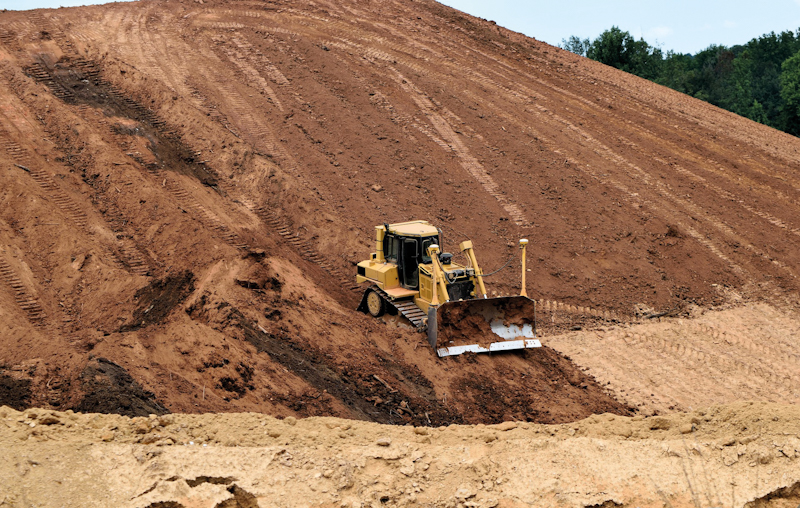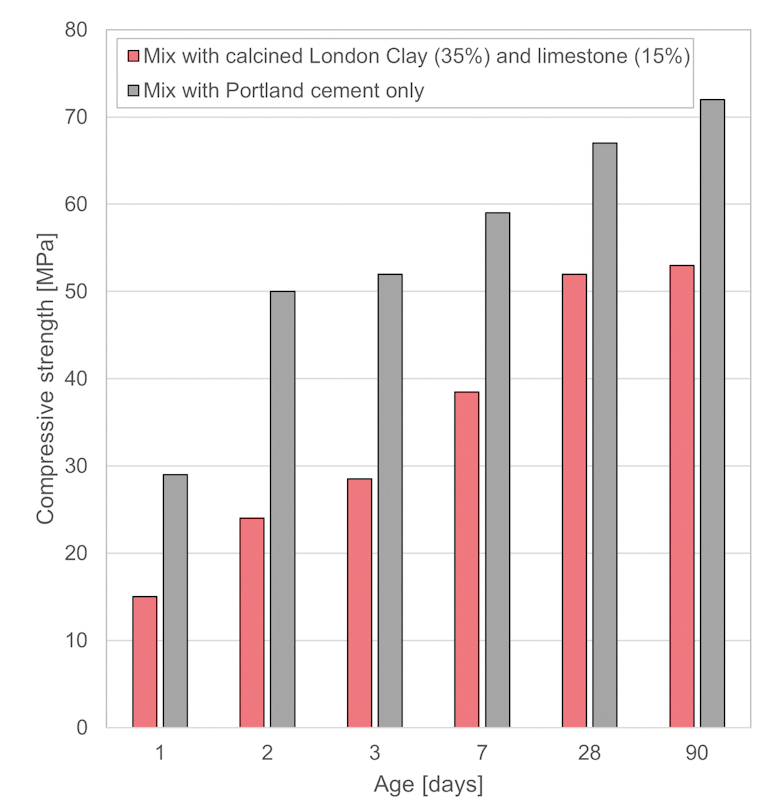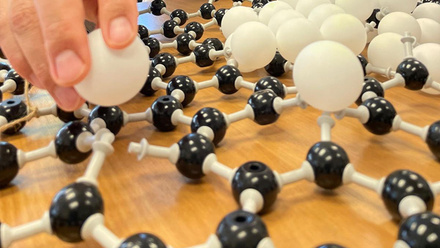Reusing waste clay from excavations and tunnelling
Dr Fragkoulis Kanavaris MIMMM of Arup discusses the potential of reusing waste clay arisings from excavations as supplementary cementitious material or expanded clay aggregate in concrete.

Population growth and rapid urbanisation in the context of climate crisis and resource depletion require the construction industry to revisit its traditional linear material sourcing and disposal practices. Alternative techniques should be adopted to respond to the increasing need for built assets.
With concrete being the single most widely used building material, there is a growing appetite for exploring new, accessible and low-carbon alternatives for its main constituents – cement and aggregates. However, the stock levels of the principal sources of Portland cement replacements – fly ash and ground granulated blast furnace slag – are declining, particularly in Europe. This is due to the gradual phase-out of the industries generating them, namely coal mining and primary steel making.
Meanwhile, waste management and construction logistics, particularly for projects in dense, urban environments, are also complex to execute and challenging for the budget and programme, as well as adversely impacting the environment and local surroundings.
Tunnelling and deep excavations, for example, generate large volumes of spoil that need to be transported and disposed offsite, with the associated increased carbon emissions, air pollution and costs. Normally, this material is sent to landfill, or on certain occasions, if it is deemed suitable, it may be used as backfill in the same construction project.
In major infrastructure projects, however, the waste generated is usually considerable in volume and only a small fraction of it can be reused in the same construction.
Major infrastructure projects are now facing the challenge of coming up with ways to enable high-value repurposing of excavation waste, as opposed to low-value repurposing. High-value uses would involve converting excavated waste to a construction and building material that can be used in the same or other projects.
The potential to transform excavated spoil into a useful construction resource like concrete has largely remained untapped so far.
Clays in concrete
Clays in their raw form may be treated as inert materials, with particular relevance to concrete. However, heating certain clays up to 700-900°C – a process known as calcination – can attribute cementitious properties in such clays and enable their use in concrete as a supplementary cementitious material (SCM) to replace Portland cement.
The calcination temperature for clays is much lower than that needed for Portland cement – approximately 1,400°C for the latter – resulting in a lower embodied carbon.
The key parameter that commonly dictates the reactivity of a clay, and hence its suitability as an SCM, is the kaolinite content. The higher the kaolinite content, the greater the reactivity of the clay and its potential to be used as an SCM in concrete. Generally, a clay with less than 40% kaolinite content would be considered as low-grade reactivity clay, one with 41–70% kaolinite content as medium-grade, and one with greater than 71% as high-grade.
High-grade clays are those that can be used to produce metakaolin – a highly reactive SCM. Previous work has indicated that medium-grade clays could also be used to produce structural concrete.
However, studies of calcined clays in the UK are limited and there have been no large-scale applications of concretes with calcined clay. Recent advancements in the field are rapidly changing this. Moreover, the work explored here reveals the potential of using low-grade clays in structural concrete.
The case of London Clay – described in this article – is one of the first interdisciplinary research projects with industrial applications of calcined clay in wider Europe.
The untapped potential of calcined clays
The untapped potential of calcined clays
Clays and calcined clays, in particular, have a relatively long history of being used in concrete-like materials. The Romans and ancient Greeks were among the first who used similar materials – for example, natural pozzolans and pozzolanic ashes. Calcined clays were also used in South America in the construction of concrete dams to reduce the Portland cement content.
Recently, calcined clays have been used in combination with limestone and Portland cement to form a cementitious material known as LC3, with promising properties owing to the synergistic effects between calcined clays and limestone. There has been less attention on using calcined clays as direct Portland cement replacement in concrete and particularly the use of low-grade clays.
In the UK, BS 8615:2019 Parts 1 and 2 specify the requirements of the chemical composition of calcined clay for use in concrete. The national UK concrete specification document, BS 8500-1, permits the use of calcined clay in concrete under certain exposure conditions at percentages of up to 55%.
However, calcined clays have not been commercialised yet in the UK and Europe, and there is no consistent industrial production of calcined clay documented
in the country (except for a company called Banah, which stopped producing calcined clay a few years ago).
One of the reasons is a lack of guidance with respect to the suitability of clays and the processing required to produce calcined clay of consistent quality.
RILEM TC 282-CCL is working towards drafting and disseminating such guidance – with several relevant pre-standard documents published already – to increase confidence in using calcined clays in the UK.
Keeping it REAL
High Speed 2 (HS2) is a major railway project connecting the North of England and the South East, and considerable quantities of London Clay are being excavated as a result.
Deciding what could be done with the waste clay has been particularly challenging for the design team since its inception, owing to the cost and carbon emissions associated with transportation, disposal, recycling and landfilling.
Around four and a half years ago, the idea of using excavated London Clay from tunnelling operations to produce calcined clay was proposed at Arup, and since then it has evolved into a HS2-funded multidisciplinary project on Re-purposed Excavated Arisings Loop (REAL), with several industrial and academic partners.
The project, now co-led by Arup and SCS Railways, encompasses the following objectives:
- Develop an approach for converting raw excavated London Clay to calcined London Clay for use as an SCM in concrete.
- Develop an onsite mobile clay processing facility so the clay can be collected, calcined and prepared for use as a qualifying SCM for concrete.
- Investigate the potential of manufacturing expanded clay aggregate from excavated London Clay.
Striving for consistency
London Clay is known to exhibit low kaolinite content – 10-20% and in some cases up to 30%. It can also be highly variable depending on the location and depth.
A comprehensive investigation has been carried out on how excavated London Clay from various locations and tunnelling arisings can be converted into a calcined clay and expanded clay aggregate of consistent quality.
The developed method means a calcined clay can be produced that is suitable for replacing part of the Portland cement in concrete. The method involves collecting excavated London Clay, followed by initial oven drying at approximately 40°C for 24 hours. The initially dried material is then passed through a jaw crusher and then through a 10mm sieve. This is then followed by the material’s calcination at 800°C for one hour and subsequent grinding to a maximum particle size of 100μm.
Initial results indicate that 50% of Portland cement in concrete can be replaced with this calcined London Clay, and even limestone, while still producing a concrete with 50MPa at 28 days (see graph below).

It is also possible to produce expanded clay aggregate from the excavated London Clay – although such aggregate would mainly be suitable for low-strength lightweight concrete applications, or could be used as infill material.
The design of a mobile clay processing facility is being finalised. The aim is to collect the excavated clay directly from the tunnel boring machine and process it ‘on-the-spot’ to produce usable calcined London Clay for concrete applications relevant to the project to maximise circularity.
The REAL project demonstrates the potential of reusing waste clays as meaningful construction resources that offer a more environmentally sustainable solution for concrete. There are other clays that could be used for the same purpose in different regions of the country and throughout Europe, which are excavated as part of infrastructure, building or mining projects. Such a transformative approach to excavated material can aid excavation spoil management and deliver reductions in concrete’s carbon footprint.
Did you know?
Crossrail, a UK railway construction project connecting west to east London on the new Elizabeth Line, included 21km of twin-bore tunnels excavating around 7Mt of soil.Around half of this quantity was reused or recycled. The remaining was shipped to Wallasea Island – the site of a former farm on the Essex coast – to create a 165mln m² area comprising multiple intertidal habitats.
This incentive has enabled a nature reserve, owned and operated by the Royal Society for the Protection of Birds, but with associated transportation-related costs and CO2 emissions.







